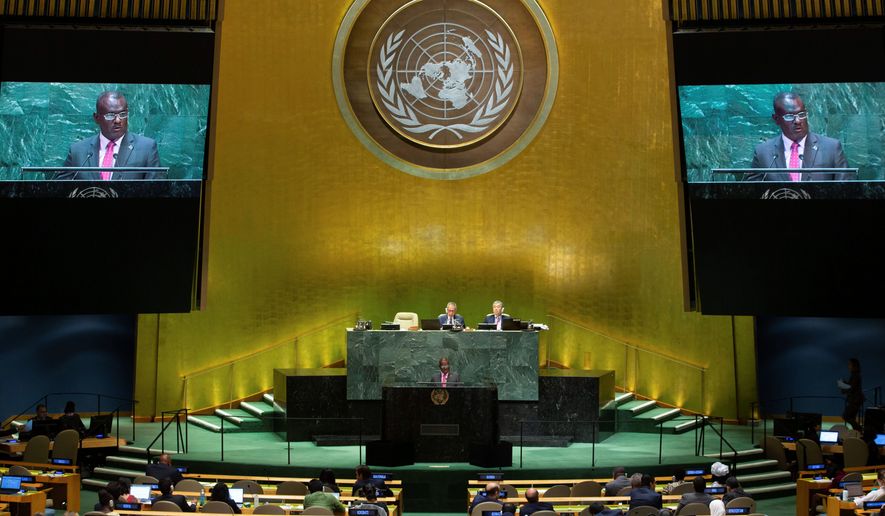OPINION:
If every cloud has a silver lining, no one told the United Nations. Casting an apprehensive eye toward the future of the planet, the world body is wringing its hands over dark threats hiding under the bed. Fortunately, silver linings are out there, indicating brighter days ahead.
The U.N.’s annual global forecast, released on Jan. 16, paints an anxiety-filled picture of humanity as the new year progresses, stumbling over uneven ground strewn with ominous obstacles. The main peril previewed in its report, titled World Economic Situation and Prospects 2020, results from a slowdown in global economic growth during 2019, which it measured at 2.3 percent, owing to “prolonged trade disputes.”
Looking ahead through 2020, the report placed likely global growth in the 1.8-2.5 percent range, depending on the emergence of “a flareup of trade tensions, financial turmoil, or an escalation of geopolitical tensions.” At the risk of seeming to be indifferent, it sounds like another year of business as usual on the big blue orb that humanity calls home.
The U.N. exists, though, to combat the all-too-human tendency toward indifference, and it reports that a slowing global economy could threaten efforts to eradicate poverty and create jobs, especially at a time when “pervasive inequalities and the deepening climate crisis” are contributing to worldwide turmoil. “These risks could inflict severe and long-lasting damage on development prospects,” writes U.N. Secretary-General Antonio Guterres in an accompanying statement. “They also threaten to encourage a further rise in inward-looking policies, at a point when global cooperation is paramount.”
The U.N. chief may not have noticed, but there are signs that 2020 could actually prove a blue-ribbon year. Before the U.N. sent warning signals up the flagpole from its headquarters in New York, President Trump nailed down a landmark deal with top U.S. trading partners in Washington. On Jan. 15, the president joined China Vice-Premier Liu He in signing the Phase One trade agreement with China. Nearly two years in the making, the pact begins the process of leveling the commercial playing field, which has long given China a competitive advantage.
Importantly, China agreed to end its practice of requiring U.S. companies to transfer technology to Chinese partners as a condition of market access. The Asian giant has agreed to halt intellectual property theft and currency manipulation, which gives its products an advantage in global markets. China also pledged to purchase an additional $200 billion in U.S. goods and services during the next two years. In return, the United States has agreed to cut tariffs from 15 percent to 7.5 percent on $120 billion worth of Chinese products.
The president bagged a second major economic victory when the U.S. Senate joined the House in passing the U.S.-Mexico-Canada Agreement by a vote of 89-10. The deal is expected to add three-quarters of a point to U.S. gross domestic product, create around 350,000 jobs per year and attract $100 billion in new foreign investment, says National Economic Council Director Lawrence Kudlow.
Commerce is king for the man from the Empire State, and he touted its salutory effects before global leaders Tuesday at the World Economic Forum in Davos, Switzerland: “Perhaps the most transformative change of all is on trade reform, where we’re addressing chronic problems that have been ignored, tolerated, or enabled for decades.” Indeed, it is a fact that Mr. Trump eased “trade tensions” — a U.N. bugaboo — with nations the International Monetary Fund reckons account for nearly 45 percent of the global economy, in the course of just two days.
U.S. stock markets have climbed during the Trump era, with the Dow Jones Industrial Average up 60 percent since Election Day 2016 and 20 percent over the past year. And ripples of prosperity are widening: During the past 12 months, stocks in China have risen nearly 19 percent; India, 14 percent; Germany, 22 percent; and Russia, 40 percent.
Trade that triggers robust economic growth is easing some of the major headaches troubling the United Nations. For example, extreme poverty that gripped 40 percent of China’s population in 2000 has fallen to a vanishingly small 0.2 percent, according to the World Bank.
Nations that establish fair trade are less likely to trade hostile fire. Trump-style deal-making is a form of diplomacy that yields not just peace, but prosperity. It could prove a silver lining to the U.N.’s ominous forecasts.




Please read our comment policy before commenting.